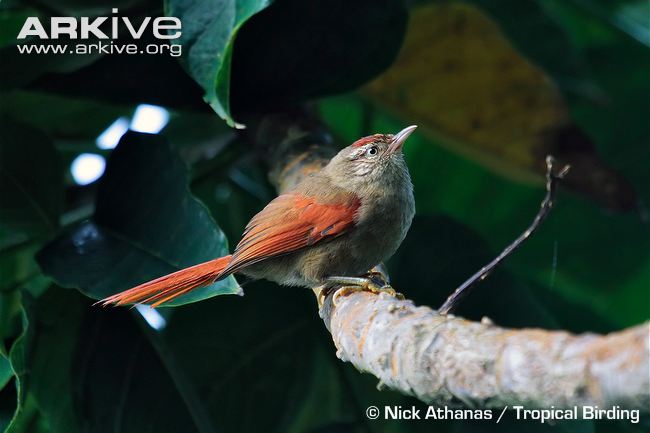
Cranioleuca hellmayri
SUBFAMILY
Synallaxeinae
TAXONOMY
Cranioleuca hellmayri Bangs, 1907.
OTHER COMMON NAMES
French: Synallaxe des bromйliades; German: Strichelkopfschlьpfer;
Spanish: Pijuн de Reiser.
PHYSICAL CHARACTERISTICS
Body length is about 5.5 in (14 cm). Bill is short, almost
straight, and pointed. The body is slender, and the tail long
and tipped with small spines. The sexes are similar. The back
is colored dark olive-brown, the tail is rufous, the wings are
olive-brown with large rufous patches, the throat is white, the
belly is light olive, the crown of the head is rufous streaked
with black, and there is a whitish stripe over the eye.
DISTRIBUTION
An endemic species that only occurs in a small area, in the
Santa Marta Mountains of northern Colombia.
HABITAT
Inhabits slopes with montane humid forest, mature second
growth woodland, and forest edges. Mostly occurs at elevations
of 5,250–9,850 ft (1,600–3,000 m).
BEHAVIOR
Occurs as pairs. The song is a series of shrill notes, falling in
intensity and pitch.
FEEDING ECOLOGY AND DIET
Forages acrobatically in the forest canopy, even hanging upside-
down, for insects and other small invertebrates.
REPRODUCTIVE BIOLOGY
Constructs a large, bulky, roughly spherical nest of mosses and
other fibers, with a side entrance, and attached to a drooping
outer limb of a tree. Both the male and female incubate the
eggs and rear the nestlings.
CONSERVATION STATUS
Not threatened. A very local species, but abundant within its
highly restricted range.
SIGNIFICANCE TO HUMANS
None known.
Other popular Animals
Photo Gallery of - Streak-capped spinetail




 Animalia Life
Animalia Life